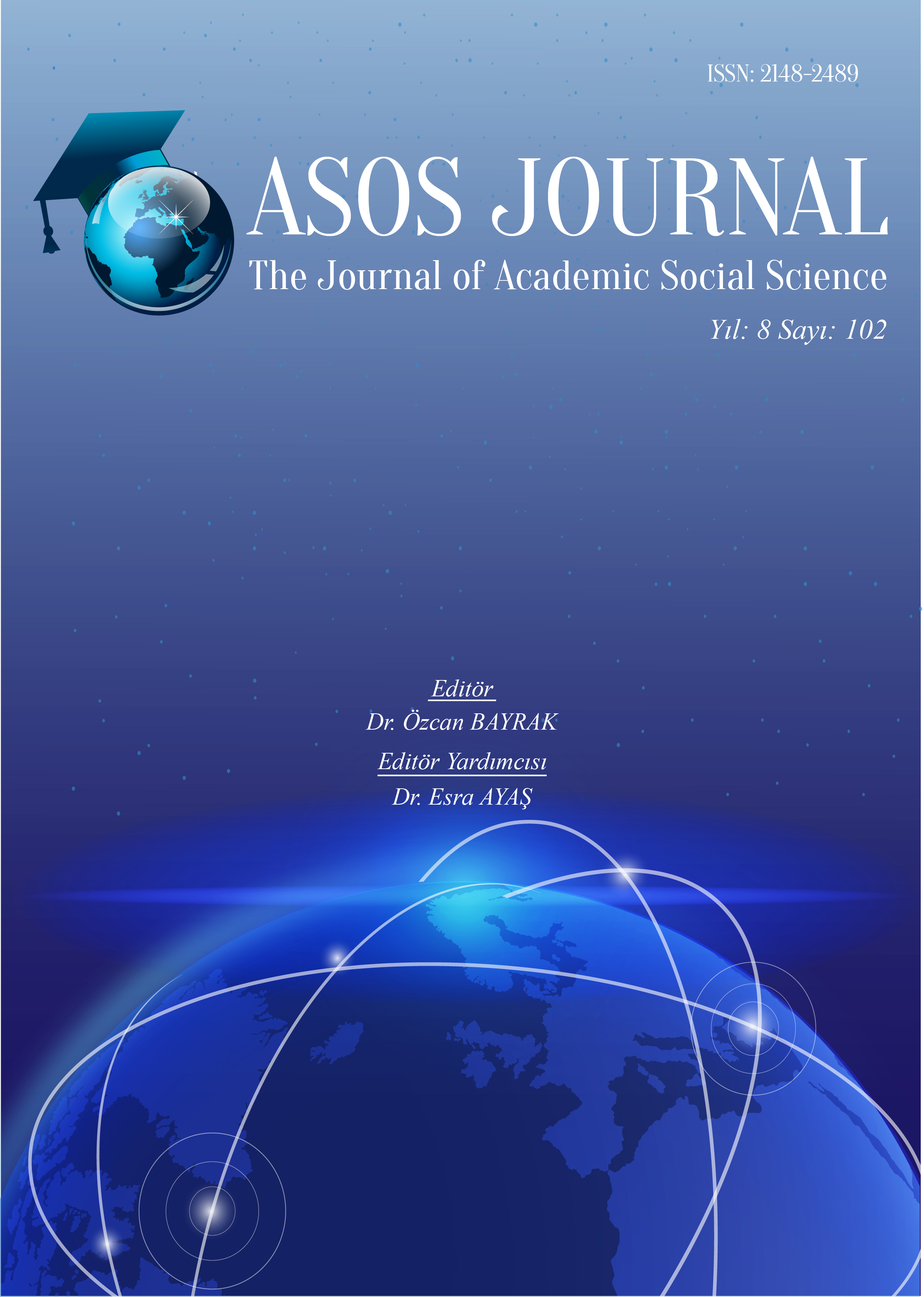Author :
Abstract
Görsel senaryonun tarihi sinemaya öykünün girişi kadar eskidir. İlk örneklerine 1900’lü yılların en başında, Méliès’in fantastik filmlerinin eskizlerinde rastlanmıştır ve o zamandan bu yana animasyon ve reel görüntü filmleri gibi görsel-işitsel anlatılarla ve çizgi roman türüyle birlikte gelişim göstermiştir. Dolayısıyla çalışmada öncelikle görsel senaryonun teorik temelleri üzerinde durulmuş, benzeri anlatı sistemleriyle karşılaştırması yapılarak mevcut türsel karışıklıkların önüne geçilmesi amaçlanmıştır. Görsel senaryolar diğer ardışık sanatlar gibi sanatsal dışavurum ya da özgün bir öykü anlatmak için değil, aynı metinsel senaryo gibi görsel-işitsel prodüksiyona yönelik üretilen bir tür olarak görülmektedir. Filmik yapının tüm öğeleriyle ilişkili olmasından dolayı, senaryoyu görselleştiren sanatçı bütün film ekibini ilgilendiren bir çalışma ortaya koymakta, bilhassa yönetmenle, yapımcıyla ve senaristle birlikte iş yürülmesi önem taşımaktadır. Bir pre-prodüksiyon çalışması olan görsel senaryo, filmin bitmiş halinin tüm ekip tarafından aynı şekilde hayal edilebilmesini mümkün hale getirmektedir. Bu nedenle görsel senaryoda yer alan statik çizimlerin harekete dayalı prodüksiyonlara yol gösterebilmesi için, filmik öğeleri ifade edecek şematik bir dile ihtiyaç duyulmaktadır. Ancak görsel senaryo dili kapsamlı ve çok yönlü bir yapıya sahip olduğu için bu çalışma reel görüntü filmleri açısından önemli ve temel bir konu olan kamera çekim ölçekleri, açıları ve kamera hareketleriyle sınırlı tutulmuştur. Çalışmada görsel senaryo diline ait, hala gelişim aşamasında olan ifadeler ve kısaltmalar incelenmiş, eksik görülen kısımlara yeni eklemeler yapılarak şematik bir temsil biçimi önerilmiştir.
Keywords
Abstract
The history of the storyboard is as old as the history of storytelling in cinema. First examples of storyboard were found in the sketches of the fantastic films of Méliès at the beginning of the 1900s and since then it has evolved with audiovisual narratives such as animation and live-action films, and comic book genre. Therefore, the study focused primarily on the theoretical bases of the storyboard, and by comparing it with similar narrative systems, it is aimed to eliminate existing confusion. Storyboards are seen as a genre produced for audiovisual productions, just like the textual scenario, not for artistic expression or telling a unique story like similar Sequential arts. Since the storyboard is related to all the elements of filmic structure, the artist who visualizes the scenario reveals a work that concerns the entire film crew, and it is important to work with the director, producer and screenwriter. The storyboard, which is a pre-production work, makes it possible to imagine the finished version of the movie in the same way by the whole team. Therefore, a schematic language that expresses the filmic elements is needed in order to guide motion-based productions with the static drawings in the storyboards. However, since the storyboard language has a comprehensive and miscellaneous structure, this study has been narrowed to camera shooting scales, angles, and camera movements, which is an important and essential subject for live-action films. In the present study expressions and abridgements belonging to the storyboard language, which are still in the development stage, were examined, and a schematic representation form was proposed by making new additions to the missing parts.
Keywords
- Ablan, Dan, (2002), Digital Cinematography&Directing, USA: New Riders Publishing.
- Bluth, Don, (2004), The Art of Storyboard, USA: DH Press.
- Brown, Blain, (2012), Cinematography: Theory and Practice, Second edition, USA, Uk: Focal Press.
- Christianson, David B.; Anderson, Sean E.; He, Li-wei; Salesin, David H.; Weld, Daniel S.; Cohen, Michael F., (1996), “Declarative Camera Control for Automatic Cinematog
- 12 Türkçeleştirmeler ve kısaltmalar öneri olarak yazar tarafından yapılmıştır. raphy”, AAAI'96: Proceedings of the thirteenth national conference on Artificial intelli- gence - Volume 1 August 1996, s.148–155.
- Cohn, Neil, (2019), Visual Narrative Comprehension: Universal or not? Springer, Psychonomic Bulletin & Review.
- Cohn, Neil, (2013), The Visual Language of Comics: Introduction to the Structure and Cogni- tion of Sequential Images, UK, USA: Bloomsbury Publishing Plc.
- Cohn, Neil, (2012), “Comics, Linguistics, and Visual Language: The past and future of a field”, (Ed. Frank Bramlett), Linguistics and the Study of Comics. New York: Palgrave MacMillan, s.92-118.
- Duncan, Randy; Smith, Matthew J., (2009), The Power of Comics: History, Form and Culture, NY, London: Continuum Int. Pub. Group Ltd.
- Eisner, Will, (2000), Comics and Sequential Art, 19. Baskı, USA: Poorhouse Press.
- Gabler, Neal, (2007), Walt Disney: The Triumph of the American Imagination. New York: Vin- tage Books. s.181–189.
- Haesen, Mieke; Meskens, Jan; Luyten, Kris; Coninx, Karin, (2010), “Draw Me a Storyboard: Incorporating Principles & Techniques of Comics”, Proceedings of the 2010 British Computer Society Conference on Human-Computer Interaction, United Kingdom.
- Hall, Brain, (2015), Understanding Cinematography, USA: The Crowood Press Ltd.
- Halligan, Fionnuala, (2014), Movie Storyboards: The art of visualizing screenplays, USA: Chronicle Books.
- Hart, John, (2008), The Art of the Storyboard: A Filmmaker’s Introduction, UK: Focal Press, Elsevier.
- Katz, Steven D., (1991), Film Directing Shot by Shot: Visualizing from Concept to Screen.
- Lefèvre, Pascal, (2007), “Incompatible Visual Ontologies? The Problematic Adaptation of Drawn Images”, (ed. Ian Gordon, Mark Jancovich, Matthew P. Mcallister) Film and Comic Books, s. 1-12, USA: University Press of Mississippi.
- Mccloud, Scott, (1993), Understanding Comics: The Invisible Art, USA, NY: HarperPerennial.
- Pallant, Chris; Price, Steven, (2015), Storyboarding: A Critical History, UK: Palgrave Macmil- lan
- Pardew, Les, (2005), Begining Illustration and Storyboarding for Games, USA: Thomson Cour- se Technology PTR
- Ronfard, R.; Gandhi, V.; Boiron, L., (2013), “The Prose Storyboard Language: A Tool for An- notating and Directing Movies”, 2nd Workshop on Intelligent Cinematography and Editing part of Foundations of Digital Games - FDG 2013, May 2013, Chania, Crete, Greece.
- Sokolov, A.G., (2007), Sinema ve Televizyonda Görüntü Kurgusu, (çev. Semir Aslanyürek), 2. Baskı, İstanbul: Agora Kitaplığı.
- Thompson, R.; Bowen, C., (2009). Grammar of the Shot, 2. Baskı, USA, UK: Focal Press.
- Ünal, Yörükhan, (2008), Dram Sanatı ve Sinema: Anlatım Olanakları ve Sınırlılıkları, İstanbul: Hayalet Kitap. İNTERNET KAYNAKLARI
- http-1: https://www.nytimes.com/2019/09/12/arts/design/nyc-this-weekend-art-
- http-2: https://film-storyboards.be/templates/2017/10/23/indesign-storyboard-template.html





